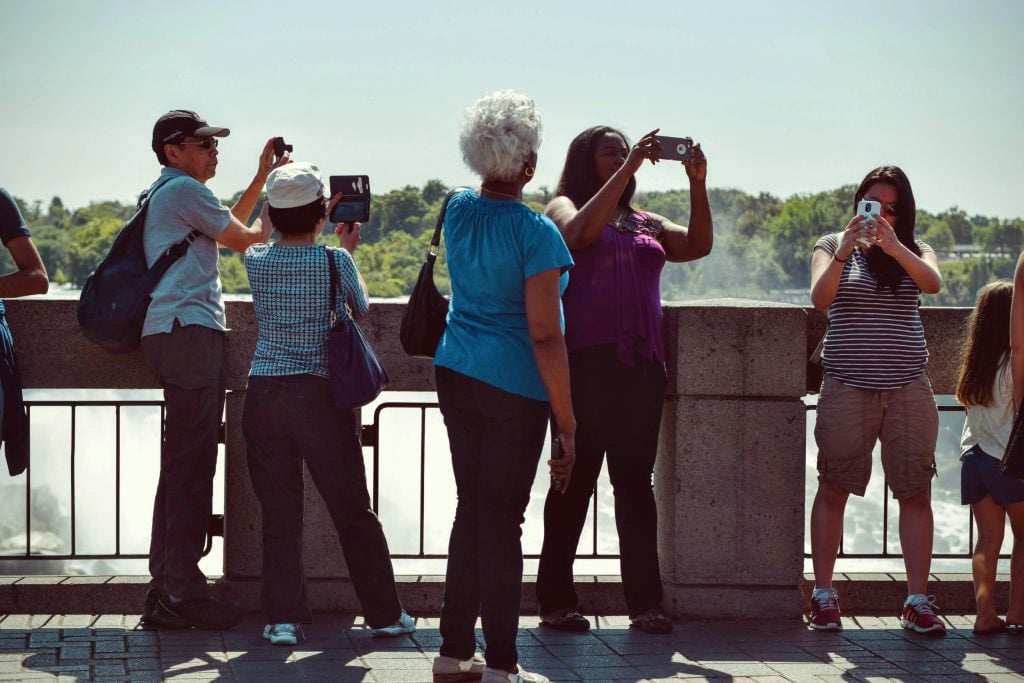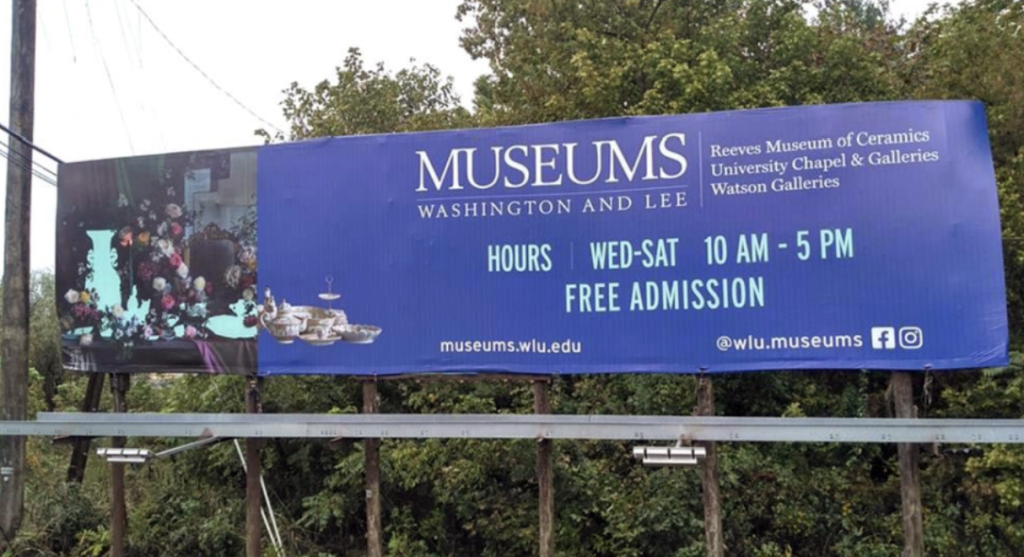Marketing to tourists doesn’t always follow the same rules as traditional marketing. Visitors are often unfamiliar with the region and on a time crunch, but because of that, they may also be more receptive to advertisements they see in places like airports, highways, or tourist hotspots.
So, what’s the most effective way to grab their attention?
Because tourists are on the move, the best way to captivate them often involves reaching them where they are—literally. Out-of-home (OOH) advertising shines in a way that digital ads on your phone just can’t. They can be in your face and take up an entire building, hover over baggage claim areas as backlit dioramas in an airport, or take on a more traditional format by sitting alongside highways.
Below, we’ll explore how to create an effective tourism marketing strategy centered around OOH. We’ll also break down all the need-to-knows before you start advertising to tourists. Ready to get started on your campaign right away? Fill out our online form.
Here’s what we’ll cover in this post:
- What is tourism marketing?
- Knowing your target audience
- Picking the right location
- Using an eye-catching design
- Being aware of busy months
- Combining OOH with digital channels
- Considering renting multiple boards
- Testing creatives on digital boards
What is Tourism Marketing, and Why Is It Important?
Before you learn about how to advertise to tourists, let’s take a step back and focus on what tourism marketing is and why it can be so successful.
Tourism marketing is a form of advertising that targets people visiting from outside your local area—whether they’re from a different city, state, or country—and markets your products or services during their trip. While it’s often associated with hotels or airlines, any business can benefit from tourism marketing as it taps into a potentially new customer base.

Now is an especially great time to invest in tourism marketing, as international travel has already surpassed pre-pandemic levels across most regions of the world. The World Travel & Tourism Council even predicts that travel and tourism will grow by 5.8% into 2032—more than twice the growth rate of the entire global economy.
It’s highly profitable if you can develop a marketing plan that works, which is why you’ll need to incorporate these elements into your tourism marketing plan:
1. Know Your Target Audience
No matter how dazzling your billboard looks, you won’t get far if you don’t know who you’re talking to. There isn’t a business that can succeed without first knowing its target audience, and it isn’t possible to just throw messaging at a campaign, hoping it will stick.
Who typically visits the place where you’re thinking about marketing? Is it families looking for budget-friendly entertainment, solo travelers chasing adventure, or high-end travelers looking to visit an often fully booked summer destination?
By pinpointing what really excites these groups or even solves a potential problem, you can create ads that speak directly to their interests. Thoughtfully engaging your target audience is the most crucial aspect of advertising to tourists because it affects every moving part of your campaign.
Once you have that knowledge, design your billboard to match their expectations—maybe it’s highlighting a kid-friendly attraction, a new indoor rock-climbing facility, or even a local restaurant less than a mile down the road.
The more your campaign connects with who they are and what they want, the more likely they’ll see your billboard as an invitation instead of just another passing ad.
There are even ways to change your billboard’s entire design or messaging with digital out-of-home ads (DOOH). More on this below.

2. Pick the Right Location
Tourists typically don’t stay still—they’re driving toward or away from airports, dropping by popular landmarks, or frequenting entertainment districts. If you want your billboard noticed, you’ll need to pick the right location to effectively advertise to tourists.
Highways leading into the city? Check.
Downtown near the must-see attractions? Absolutely.
Airport corridors where visitors collect their luggage or pick up rental cars? That’s prime real estate, too. Airport advertising has soared in recent years.
By covering these entry and exit points, you can be the first or last thing tourists see. They might glance at your ad while navigating a new city and think, “That looks fun,” and take a detour right then and there.
Or maybe they’ll remember it later that day when deciding where to eat or what to do next. Either way, you have to think about prime locations before deciding what actually goes on your billboard.

3. Use Big, Legible Text and an Eye-catching Design
Once you’ve identified your target audience and picked the perfect location for your billboard, you’ll need to meet some nonnegotiables by verifying that your ad:
1. Grabs attention at a glance
2. Can be read in only seconds
3. Conveys your message (and can be understood) in as few words as possible
Whether you’re creating a mockup of your ad in Adobe Photoshop by yourself or working with an outdoor advertising agency with an in-house designer, follow these tips when designing an outdoor advertisement:
4. Be Aware of Your Busy Months
Before you invest in billboard advertising, research the times of year when an area sees the greatest influx of visitors.
Is the city you’re looking to place billboards famous for festivals? Does it host popular winter holiday events? Maybe it’s a city like New Orleans that’s famous for Mardi Gras or a town like Aspen, Colorado that’s well-known for weekend to weeklong ski trips.
You’ll need to understand when the busiest months are for tourist destinations to make sure your campaigns leave the strongest impact.
When a sea of tourists arrives, you want your billboards in prime locations and your messaging aligned with what these visitors are likely seeking. In other words, plan your billboard presence to hit when traffic is at its highest.
Another reason identifying busy months is so critical is that it allows you to keep consistency across channels. If someone spots your billboard marketing a holiday special and sees a similar post on social media or in an email newsletter later in the day or week, it might be the push they need to take action.
5. Combine OOH with Multiple Digital Channels
Even the most striking billboard benefits from a little digital backup.
In fact, according to the Out of Home Advertising Association of America (OOH), billboard advertising works best when combined with other campaigns.
Here’s an example: someone visiting from out of town over the weekend sees your ad in an airport and then later checks social media in their hotel room. Then, they see your brand pop up once again in an ad on their phone. That sense of familiarity can prompt them to explore your brand even further, meaning they might visit your website and book a reservation at your restaurant or buy your product.
Regardless of your business, the goal is still the same when you advertise to tourists (or anyone for that matter): engagement.

Let’s run through another scenario where someone’s planning a vacation a few months away from now, but they’re just waiting for a good offer to sway them.
If someone sees your ad while sitting in the passenger seat of their car and notices that it’s offering a great deal for a domestic flight, they might scan the billboard’s QR code, which can take them to a landing page on their phone. It might even ask things like the prospective month they plan to book a flight or how much they want to spend.
Once they fill out this information, it starts the process of personalized email automation, which can now do the heavy lifting of marketing. They’re now in your system to receive a welcome email, future promotional emails, or product updates from your newsletter.
Remember, while OOH should remain your focus, combining it with digital marketing can lend leads. By collecting details on potential customers from a billboard offer, you can market to them as they prepare for their trip or while they’re in town, nudging them to choose your business over others.
That offline-to-online marketing tactic can be the difference between a casual glance and a conversion.
6. Consider Renting Multiple Billboards to Advertise to Tourists
Sometimes, one billboard just won’t cut it—especially if visitors pour in from different highways or pass through various parts of town. Planting multiple billboards strategically means travelers might see your message at the airport and then again as they head downtown, reinforcing brand recognition every step of the way.
Beyond coverage, renting multiple boards can also unlock discounts or added benefits from advertising companies. This flexibility allows you to highlight different aspects of your offer—maybe a family-friendly image near a theme park and an upscale version downtown for business travelers. Each time someone spots your logo or slogan again, it tightens the connection between your brand and their upcoming plans, making it more likely they’ll choose you over a competitor they’ve never heard of.
7. Swap Out and Test Creatives on Digital Billboards
Unlike traditional static signs, digital billboards can let you rotate multiple ads or messages instantly through programmatic OOH—which essentially automates OOH advertising—and can give you an enormous advantage when developing tourism marketing campaigns.
If you notice a spike in website traffic or QR code scans after a particular version goes live, you can switch your creative accordingly in real time. Certain contracts will allow for free creative swaps, so you can pivot between billboard designs or messaging during your campaign’s duration.

This flexibility also opens the door to A/B testing. Maybe one ad is written to target tourists staying briefly in New York City in the summer and another is written to target wide audiences during a major event like the Times Square Ball Drop.
Or, if tourists visiting a destination interact more with ads while still planning their trip compared to when they’re already close by, you can tailor messaging to focus on “bucket list experiences” early on and “last-minute deals” as they approach the area.
The main takeaway?
You can look at the data from digital OOH billboards to give you a better idea of how you’re performing than traditional vinyl or paper billboards. This means measuring ROI becomes more straightforward—you’ll know how many viewers scanned your code, visited your site, or used a promotion, allowing you to refine your campaign as it pans out.
Need Help Advertising to Tourists?
Tourists won’t be in the area forever, but if you market correctly, you’ll make a lasting impression that pays off long after they’ve headed home. When you partner with Alluvit Media, you get no-cost, in-house graphic design services to ensure every detail of your billboard meets the needs of your target audience.
Your brand’s voice deserves to be heard. If you’re ready to get your message out there with the help of an experienced team, fill out our billboard request form to get started.
FAQs
What makes tourism marketing different from local advertising?
Unlike locals, tourists are unfamiliar with the area and often make quick, spontaneous decisions. That means your messaging needs to be clear, immediate, and easy to act on. A great billboard might show them where to eat, stay, or shop within minutes of seeing it—helping them make fast choices during limited time in town.
How can I make my tourist ad stand out?
Keep it simple. Use bold colors, large fonts, and a clear call-to-action that can be read in seconds. If possible, use digital billboards to test different creatives or rotate seasonal messages. The more relevant and visually striking your ad is, the more likely it will catch a traveler’s eye.
